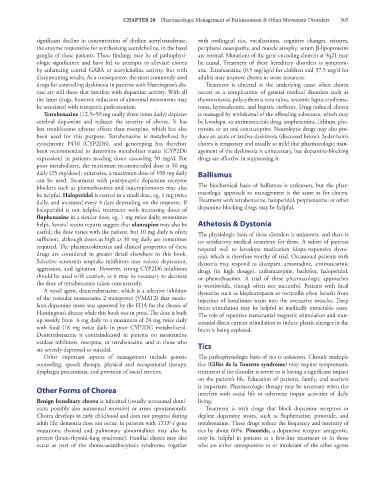Page 519 - Basic _ Clinical Pharmacology ( PDFDrive )
P. 519
CHAPTER 28 Pharmacologic Management of Parkinsonism & Other Movement Disorders 505
significant decline in concentration of choline acetyltransferase, with orolingual tics, vocalizations, cognitive changes, seizures,
the enzyme responsible for synthesizing acetylcholine, in the basal peripheral neuropathy, and muscle atrophy; serum β-lipoproteins
ganglia of these patients. These findings may be of pathophysi- are normal. Mutations of the gene encoding chorein at 9q21 may
ologic significance and have led to attempts to alleviate chorea be causal. Treatment of these hereditary disorders is symptom-
by enhancing central GABA or acetylcholine activity, but with atic. Tetrabenazine (0.5 mg/kg/d for children and 37.5 mg/d for
disappointing results. As a consequence, the most commonly used adults) may improve chorea in some instances.
drugs for controlling dyskinesia in patients with Huntington’s dis- Treatment is directed at the underlying cause when chorea
ease are still those that interfere with dopamine activity. With all occurs as a complication of general medical disorders such as
the latter drugs, however, reduction of abnormal movements may thyrotoxicosis, polycythemia vera rubra, systemic lupus erythema-
be associated with iatrogenic parkinsonism. tosus, hypocalcemia, and hepatic cirrhosis. Drug-induced chorea
Tetrabenazine (12.5–50 mg orally three times daily) depletes is managed by withdrawal of the offending substance, which may
cerebral dopamine and reduces the severity of chorea. It has be levodopa, an antimuscarinic drug, amphetamine, lithium, phe-
less troublesome adverse effects than reserpine, which has also nytoin, or an oral contraceptive. Neuroleptic drugs may also pro-
been used for this purpose. Tetrabenazine is metabolized by duce an acute or tardive dyskinesia (discussed below). Sydenham’s
cytochrome P450 (CYP2D6), and genotyping has therefore chorea is temporary and usually so mild that pharmacologic man-
been recommended to determine metabolizer status (CYP2D6 agement of the dyskinesia is unnecessary, but dopamine-blocking
expression) in patients needing doses exceeding 50 mg/d. For drugs are effective in suppressing it.
poor metabolizers, the maximum recommended dose is 50 mg
daily (25 mg/dose); otherwise, a maximum dose of 100 mg daily Ballismus
can be used. Treatment with postsynaptic dopamine receptor
blockers such as phenothiazines and butyrophenones may also The biochemical basis of ballismus is unknown, but the phar-
be helpful. Haloperidol is started in a small dose, eg, 1 mg twice macologic approach to management is the same as for chorea.
daily, and increased every 4 days depending on the response. If Treatment with tetrabenazine, haloperidol, perphenazine, or other
haloperidol is not helpful, treatment with increasing doses of dopamine-blocking drugs may be helpful.
fluphenazine in a similar dose, eg, 1 mg twice daily, sometimes
helps. Several recent reports suggest that olanzapine may also be Athetosis & Dystonia
useful; the dose varies with the patient, but 10 mg daily is often The physiologic basis of these disorders is unknown, and there is
sufficient, although doses as high as 30 mg daily are sometimes no satisfactory medical treatment for them. A subset of patients
required. The pharmacokinetics and clinical properties of these respond well to levodopa medication (dopa-responsive dysto-
drugs are considered in greater detail elsewhere in this book. nia), which is therefore worthy of trial. Occasional patients with
Selective serotonin reuptake inhibitors may reduce depression, dystonia may respond to diazepam, amantadine, antimuscarinic
aggression, and agitation. However, strong CYP2D6 inhibitors drugs (in high dosage), carbamazepine, baclofen, haloperidol,
should be used with caution, as it may be necessary to decrease or phenothiazines. A trial of these pharmacologic approaches
the dose of tetrabenazine taken concurrently. is worthwhile, though often not successful. Patients with focal
A novel agent, deutetrabenazine, which is a selective inhibitor dystonias such as blepharospasm or torticollis often benefit from
of the vesicular monoamine 2 transporter (VMAT2) that modu- injection of botulinum toxin into the overactive muscles. Deep
lates dopamine stores was approved by the FDA for the chorea of brain stimulation may be helpful in medically intractable cases.
Huntington’s disease while this book was in press. The dose is built The role of repetitive transcranial magnetic stimulation and tran-
up weekly from 6 mg daily to a maximum of 24 mg twice daily scranial direct current stimulation to induce plastic changes in the
with food (18 mg twice daily in poor CYP2DG metabolizers). brain is being explored.
Deutetrabenazine is contraindicated in patients on monoamine
oxidase inhibitors, reserpine, or tetrabenazine, and in those who Tics
are severely depressed or suicidal.
Other important aspects of management include genetic The pathophysiologic basis of tics is unknown. Chronic multiple
counseling, speech therapy, physical and occupational therapy, tics (Gilles de la Tourette syndrome) may require symptomatic
dysphagia precautions, and provision of social services. treatment if the disorder is severe or is having a significant impact
on the patient’s life. Education of patients, family, and teachers
Other Forms of Chorea is important. Pharmacologic therapy may be necessary when tics
interfere with social life or otherwise impair activities of daily
Benign hereditary chorea is inherited (usually autosomal domi- living.
nant; possibly also autosomal recessive) or arises spontaneously. Treatment is with drugs that block dopamine receptors or
Chorea develops in early childhood and does not progress during deplete dopamine stores, such as fluphenazine, pimozide, and
adult life; dementia does not occur. In patients with TITF-1 gene tetrabenazine. These drugs reduce the frequency and intensity of
mutations, thyroid and pulmonary abnormalities may also be tics by about 60%. Pimozide, a dopamine receptor antagonist,
present (brain-thyroid-lung syndrome). Familial chorea may also may be helpful in patients as a first-line treatment or in those
occur as part of the chorea-acanthocytosis syndrome, together who are either unresponsive to or intolerant of the other agents

